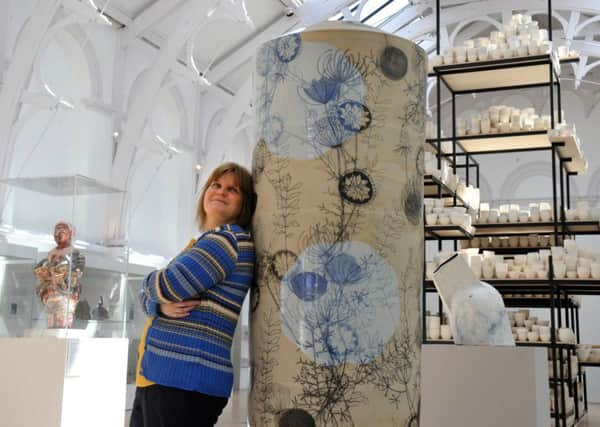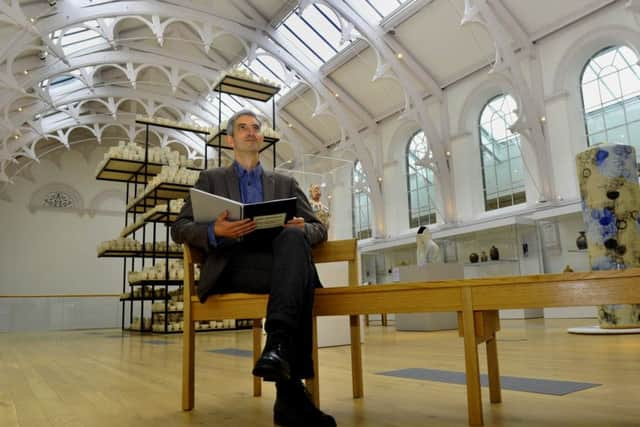Is York Art Gallery the best museum in Britain?


It’s shortly after 10am on a Tuesday morning and the staff at York Art Gallery outnumber visitors by about five to one. Sat on the steps outside is Janet Bell. The retired teacher, from Bedfordshire, is enjoying a short break in the city. It’s one which was inspired, at least in part, by reading good reports about the newly re-opened gallery and she’s just wondering whether to grab a coffee before getting her first glimpse of Clare Twomey’s Ten Thousand Pots, the looming focal point of the upstairs gallery dedicated to ceramics.
“I’ve heard so many good things about the gallery and this is the first chance I’ve had to see it for myself. I’m a bit of a frustrated potter at heart and in so many galleries the ceramics are often overlooked. Here they are the focal point and there is something really refreshing about that approach.”
Advertisement
Hide AdAdvertisement
Hide AdHer words would be music to any curators’ ears. Even more so to those at the York Art Gallery which only reopened on Yorkshire Day last August after being closed for almost two years. Just a short walk from the Minster and just opposite the Theatre Royal, which has been subject to its own impressive restoration project, £8m was spent on the revamp, but it came at a price.


While the gallery space more than doubled and the opening up of the roof space let in more, much needed natural light, the work coincided with a significant - and unexpected - reduction in the money the gallery received from York City Council.
In 2012 York Museum Trust, which runs the attraction, negotiated a five- year funding agreement for 2013-18 which was supposed to guarantee £1.2m per year, a £300,000 drop in its annual funding. However, struggling to meet its own budgets, the council later sliced a further £150,000 off the total.
“The situation is not unique and we understood, but it did mean that we had to take some difficult decisions,” says Mike Woodward, the gallery’s chief operating officer.
Advertisement
Hide AdAdvertisement
Hide AdMost difficult of all was the one which meant that when the previously free gallery opened it would have to charge a £7.50 entrance fee. The charge has hit visitor numbers. In the first six months they dropped by 40 per cent to a monthly average of 7,666. However, figures for last April rose to 9,453.


While there is still the odd rumbling of disquiet about the charges, the wider changes at the gallery were justified last week with news that York Art Gallery has made it onto the Art Fund Museum of the Year shortlist.
Also in the running are the V&A, Bristol’s Arnolfini contemporary art gallery, the Jupiter Artland sculpture collection in Edinburgh and London’s Bethlem Museum of the Mind, which opened in 2015 and is dedicated to mental health. The overall winner will receive £100,000, but for York Art Gallery the boost to its profile could be even more valuable.
“I think we were all pretty confident in the project, but these things are always a bit of a lottery so just being on the shortlist is a great achievement,” adds Woodward. “Once you introduce an admission charge to an attraction which has previously been free it will always impact on the number of people coming through the doors.
Advertisement
Hide AdAdvertisement
Hide Ad“However, there was no place left to go. What we have to do know is to give people a reason to keep coming back.”
As part of its efforts to increase visitor numbers, the trust has introduced a YMT card which gives unlimited access to the art gallery, as well as the city’s Castle Museum and the Yorkshire Museum for between £11 and £22 a year. However, key to winning over hearts and minds will be its exhibition programme.
Currently the gallery is home to the largest exhibition of British First World War Art for almost 100 years and the expansion has also created a far better showcase for its collection of British studio ceramics, which is the largest and amongst the most important in the UK.
“When I first joined the gallery in 2009 my first job was to catalogue the thousands of items in the Ismay collection,” says Helen Walsh, the gallery’s curator of ceramics. “That was a pretty good introduction to ceramics, but there wasn’t much opportunity to show off what we had. Back then there were just three cases dedicated to ceramics. Now look at what we have.”
Advertisement
Hide AdAdvertisement
Hide AdAt the heart of the renovation project was the desire to create a brand new Centre for Ceramic Art, which now stretches across two impressive exhibition spaces. The first is dedicated to 10 leading ceramicists and those whose work has been influenced by them.
“The whole process of deciding whose work we should show was pretty tortuous as we hold items by 600 different artists,” says Helen. “We were keen to include some familiar figures like Bernard Leach, who is regarded by the father of British studio pottery, but we also wanted to showcase work by some artists who have been historically overlooked.
“Painters often see their fame grow by becoming associated with one particular masterpiece, but because ceramicists tend to be more prolific and produce a greater range of work they are often harder to pin down. Before this project I think we were all frustrated that we didn’t have a showcase for our collection and anyone who wanted to see it had to make an appointment with our stores.
“There’s still a huge amount down there, but at least now we have a very visible public face.”
Advertisement
Hide AdAdvertisement
Hide AdThe tip of that very big iceberg can be seen in the second ceramic gallery, where the glass cases along one wall are filled with hundreds of pots, vases and plates, displayed in order of colour rather than chronology.
“It would have been easy to display them in date order, but the problem with pots is that they can be, well a bit brown,” admits Helen. “It’s true to an extent, but actually they are often incredibly rich in colour and that’s what we wanted to show.”
Among the works currently on display are key pieces by the likes of Lucie Rie and Hans Coper and nestled on the bottom shelf is Helen’s own favourite, a small unshowy pot by Staffordshire-born Charles Vyse.
“There is just something beautifully simple about it,” she says. “And while I probably add a new favourite to my list every month, that’s the one I keep coming back to. What’s really lovely is that word does seem to be spreading about just what an important collection we have here and every month we are contacted by someone keen to donated a new piece.”
Advertisement
Hide AdAdvertisement
Hide AdRecent donations include two elves by Christie Brown and a Peter Meanley bust of WA Ismay, whose own donation of works began the city’s ceramic collection.
“What I’ve learnt over the past year or so is that I’m really not very good at saying no. However, every piece we have been offered has a story to tell and finally that’s what the gallery is able to do.”
The Art Fund Museum of the Year winner will be announced at the Natural History Museum on July 6.